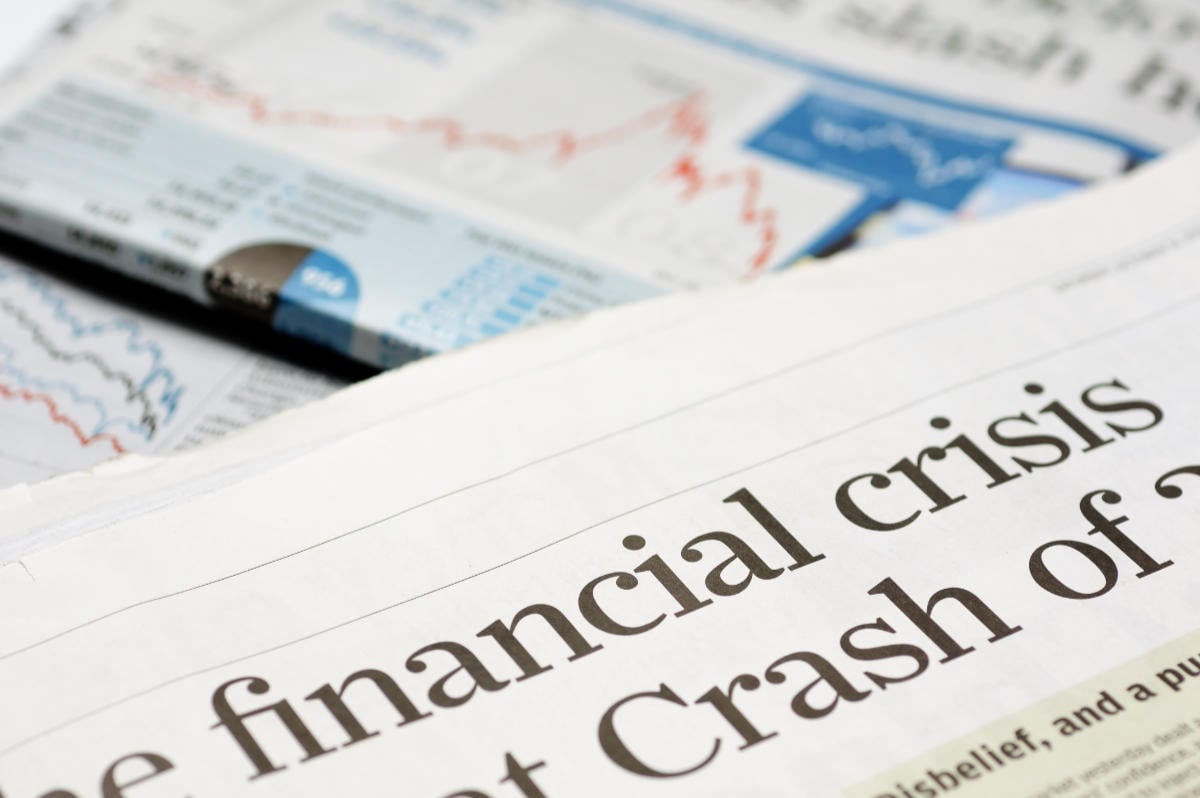
What the economy and society can expect after the Corona lockdown is currently being analyzed and forecasted on many channels. Banks in particular are a focus of interest. Especially in recessive phases, they are crucial in the financing of companies because investors are more cautious on the capital markets. The big challenge for banks in these times: Business decisions must be made with a high degree of uncertainty, because their customers are currently unable to provide valid plans and forecasts for their own business development. Everything is very much dependent on international, national, and local decisions that cannot be influenced. What does this uncertainty mean for financial institutions and which lessons can be learned from past crises?
According to current forecasts, German Federal Minister of Economics Peter Altmaier expects Gross Domestic Product (GDP) to decline by 6.3 percent in 2020 (as of April 29, 2020). This is based on the calculations of leading German economic institutes, which were presented as part of the spring 2020 projection. According to the report, the global economy will also fall into a severe recession. These figures are based on the assumption that the far-reaching measures to restrict social contacts in public spaces can gradually be relaxed and that there will be no second lockdown.
In recent weeks, however, it has become increasingly clear that the half-life of concrete forecasts of economic development is relatively short under the influence of the Coronavirus. There is too little experience with a pandemic of this size and the countermeasures in the individual countries are too diverse. This instability of global economic forecasts makes it very difficult to make a reliable assessment of the implications for the financial industry. But banks in particular are now in a key position to have a major impact on economic dynamism. In the coming months, they will have to make far-reaching and existential decisions – both for others and for themselves.
Using the 2008/2009 Economic Crisis as a Benchmark for Post-Corona Planning
When considering the possible effects on the financial industry, the financial market crisis after the bankruptcy of the New York investment bank Lehman Brothers, in September 2008, is increasingly used as a benchmark. During this crisis, almost all economies plunged into recession in 2009. In Germany alone, GDP fell by 5.6 percent in the crisis year of 2009, by 4.5 percent in the entire Euro area, and the GDP average of all economically developed countries fell by 3.4 percent. Even if today, an impending financial crisis results from the effects of COVID-19 on the real economy, some challenges for banks will be comparable to the last financial market crisis – especially since the business models of many financial institutions in Europe had already lacked profitability before Corona. This is especially applicable to the very competitive German market.
These Were the Effects of the 2008/2009 Financial Market Crisis for Banks
In order to be able to give a more differentiated analysis of the course of the 2008/2009 crisis following the collapse of Lehman Brothers, it is useful to distinguish between short-, medium- and long-term consequences.
Short-Term Effects
Following the Lehman bankruptcy, the interbank market – a major source of funding for financial institutions – collapsed due to concerns about further bank insolvencies. In addition, the reluctance of investors made further refinancing options, such as the placement of bonds, more difficult. Owing to the active maturity transformation and insufficient capital resources for such a crisis, the banks quickly became short of liquidity, which ultimately led to stagnation and a reduction in the lending business – a reaction that was inevitable for financial institutions to survive.
Medium-Term Effects
In the medium term, the financial market crisis, at least in 2009, led to a reduction in the volume of commitments for loans, which can be explained by a country- or industry-specific restriction on new business. The credit parameters also demonstrably changed in terms of risk-oriented covenants and obligations. Likewise, negative effects on the credit margin reflected the increased imputed risk costs.
Long-Term Effects
 However, these effects did not manifest themselves in the long term because the real economy stabilized comparatively quickly through government intervention and compensation by focusing on performing markets. As they were shielded from risks, financial institutions remained both capable and willing to do business and the market was able to return to the pre-crisis level after a relatively short time.
However, these effects did not manifest themselves in the long term because the real economy stabilized comparatively quickly through government intervention and compensation by focusing on performing markets. As they were shielded from risks, financial institutions remained both capable and willing to do business and the market was able to return to the pre-crisis level after a relatively short time.
What has the Financial Industry Learned from the Financial Market Crisis?
Many of the measures that were taken in and after the financial crisis are now proving to be a solid foundation during the Corona crisis. Due to extensive regulatory measures and their monitoring through capital requirements, KPIs and regular stress tests, there are currently no liquidity bottlenecks. Banks are very liquid today, which is why the financial institutions reacted quite calmly at the beginning of the Corona pandemic.
“The current crisis shows that we, as supervisors, have learned the right lessons from the last crisis. Many of the measures, which, in some cases, came under sharp criticism, are now proving to be worth their weight in gold,” said Bundesbank board member Joachim Wuermeling in an online conference held by the Deutsche Bundesbank on May 5, 2020, which served as an exchange between banks, politicians and regulators. He alluded to surplus capital and regulatory capital buffers, among other things. Bundesbank President Jens Weidmann also had a say in this event. He argued that the banks' core capital ratio had doubled from around 8 percent in 2008 to 16.5 percent in 2019.
The financial market crisis was mitigated relatively quickly through economic stimulus programs, government debt and shielding banks from balance sheet risks. It is not clear yet how fast the current crisis can be mitigated – especially since the effects are global and therefore require the global community to act together.
Which Route for the Upcoming Financial Crisis 2020/2021 can be Expected?
The causes and the scope of the crises in 2008 and 2020 are completely different, so the short-, medium- and long-term effects will also differ to some extent. Nevertheless, the lessons learnt can be used to assess the effects of the Corona crisis more realistically and to brace oneself accordingly.
Short-Term Effects: The Number of Loan Applications is Increasing
In this crisis, the political approach is again to prevent the worst. Since March 2020, initial state aid has been made available to companies, which is allocated via the credit institutions according to the 'house bank' principle. In Germany, however, an uncovered credit risk of 10 % remains with the banks in the case of Corona aid loans granted by the KfW (“Kreditanstalt für Wiederaufbau”, a German state-owned development bank). As a result, both the gross credit exposure and the net exposure of financial institutions increase.
At the moment, however, you can see the obvious: The sheer number of applications for government aid loans is a challenge for financial institutions. This leads to a strong focus on the application process in the short term. The high level of resource commitment in application-related processes will gradually spread to the back office.
For credit institutions, this means that:
- changes to significant obligations from the loan agreements (such as suspension of repayments) must be approved, documented, and carried out.
- borrowers are unable to comply with information obligations and agreements, which leads to an assessment of these cases, approval of terminations and new contractual agreements.
- the handling of revocable loan commitments and alternative financial instruments, such as promissory notes, has to be assessed based on the situation.
- they must reduce the risk-weighted assets (RWA) exposure or adjust their pricing to the increased risk, unless a margin clause (margin grid) is agreed.
Medium-Term Effects: Defaults, RWA Effects and More Tied-up Equity
In the medium term, many companies are going to experience payment difficulties as a result of the COVID-19 crisis. The immediate consequence for the financial market: an increase in loan defaults. Already in the banks' first quarterly reports for 2020, this is reflected in a significant extension of loan loss provisions. Given the already low net credit margin even before the pandemic, an increase in risk costs for banks will be a major challenge.
As in the previous financial crisis, credit institutions are likely to react to the impending increase in the bad debt ratio (non-performing loan or NPL ratio) with direct restrictions on new business. Prolongations will also be subjected to a more critical examination. While the degree of standardization increases during an economic boom, the reverse is now happening.
The crisis is also gradually being reflected in corporate financial reporting, leading to rating migration and consequently a reduction of portfolio quality. The corresponding RWA boost ties up capital, which has an impact on the profitability of risky loans and consequently on the willingness and ability of banks to provide sufficient funds.
In this context, there is a risk of credit crunch scenarios, that is, the stagnation of credit supply for the economy. Should this happen, it would lead to a suspension of investments and bottlenecks in liquidity and working capital – and thus to a progressive weakening of the real economy.
Long-Term Effects: Significant Increase in Analysis Effort
In the long term, the effort related to inventory and credit lifecycle management is going to increase significantly. The reasons for this are that the waiver rate inevitably rises, and risk-relevant parameters change. For extensive monitoring, shorter reporting intervals and higher reporting requirements (e.g., liquidity planning or updates to business planning) are necessary. The analysis in the context of inventory management gets more complex and, at the same time, lenders have an increased need for information. Since a majority of the restructuring departments have been closed in the past decade, external experts will have to be consulted during the immediate restructuring – another extra burden for financial institutions.
Conclusion
Both banks and the supervisory authorities learned from the Lehman Brothers bankruptcy and set a prudent course at that time. With the onset of the Corona crisis, financial institutions are well capitalized and there is enough liquidity to provide first aid. However, in order to remain able to act on a permanent basis, banks must now accurately anticipate the medium- and long-term consequences and take appropriate precautions. Deutsche Bundesbank board member Joachim Wuermeling also warns against blind lending in Corona times: The banking supervisory authority will take a special look at the credit risks, which are expected to become more pronounced starting in the third quarter.
To avoid substantial balance sheet and profit & loss effects, the topics of analysis, inventory management and restructuring will have to take a central place now and in the future. However, this should not lead to significant cost increases, because the cost-income ratio of many banks was already tight before the crisis.
That is why banks now need to do a sprint, adapt to the new conditions and keep an overview of portfolio risks. Support from IT systems is essential for this, which is why the digital agenda must come first, especially during this crisis.
Also read the next article of this series and find out more about the impact of the Coronavirus pandemic on portfolio management.
Image Source: Teaser: bedo - 91630491 - iStock









